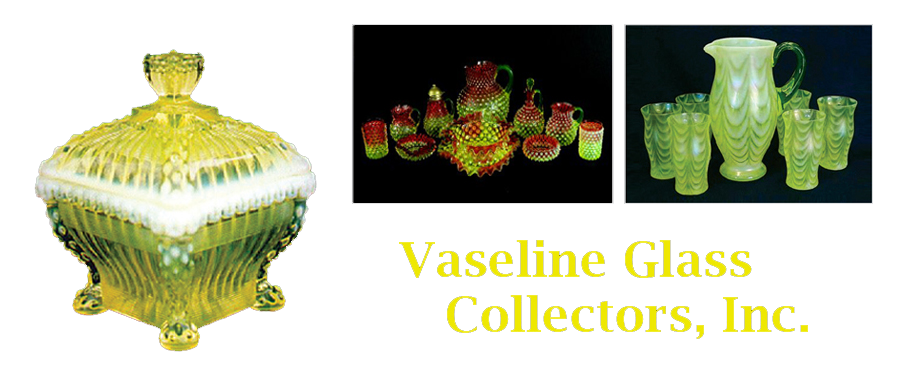Ultraviolet Black Light Fun Page
This page will show you various types of vaseline glass under a UV black light. The glass on this page has vaseline glass as it’s base glass. However, there are pieces shown here that have more than one layer of glass, one of which is a different color. This is accomplished by taking a gather of blue, red or pink glass and then taking a gather of vaseline glass over the top of that smaller gather. The end effect is blue, red or pink glass, fading down to vaseline glass at the base. Other pieces have an opalescent spot pattern, which is accomplished by taking a small gather and pressing it into a mold that puts a pattern on the glass. This small gather is cooled a little, then re-heated in the glory hole, turning the glass opaque. The glass is then blown, and the internal glass spreads, but the spot pattern where it was cooled, stays close to the same size. This allows the clear vaseline glass from underneath the gather to show through. There is also a couple of examples of cut glass, both English and Bohemian on this page. The photos represent a wide range of time, styles, and types of manufacture. All photos are from the personal collection of David and Vickie Peterson. Copying of the photos for non-commercial use and reference is allowed. Any other usage is prohibited.
ALL PHOTOS ARE LINKS TO AN ENLARGED PHOTO, WHICH INCLUDES THE UV PHOTO
This first piece is a cut glass bowl from England, about 1850-1860. This era of cutting was called the REGENCY period, due to the basic style that was utilized before mechanization of the glass cutting industry. This bowl is also much paler in shade than most English cut glass of that era. The maker is unknown. This bowl is large at a diameter of 6 1/4″ across the top and 5 3/4″ tall.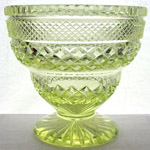
This is also a cut piece, but from Bohemia. It was made for the Persian market. It is a decorated expresso cup with matching underplate or saucer. It has been cold paint decorated in a style that was prevalent during the time period of 1850-1860. The majority of the paint still remains on this piece.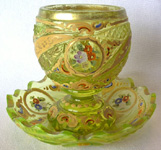
This photo grouping shows three different photos of a Rubina Verde Lampshade, shape No. 1706 (5″ fitter) by Hobbs, Brockunier & Co. The left photo shows the lamp with a 7w ‘flicker’ bulb, the center photo shows sunlight shining on the shade, and the right photo shows the lamp with a blacklight fluorescent bulb inside the lamp. Please notice how the sunlight turns the shade green, even on the outside area of the shade that usually appears red.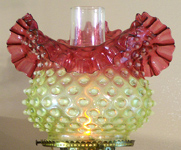
This is a very early master salt or possibly a vase for a NOSEGAY (an old word not used much today). It was made by Boston and Sandwich Company. It is canary flint glass and very heavy for it’s size. It was made about 1845-1855. Barlow & Kaiser (book #5 of their series on Boston & Sandwich Glass) called it PRESSED BALL AND GROOVE SALT. Clark W. Brown (SALT DISHES, copyright 1937) called it PETAL & BULLSEYE.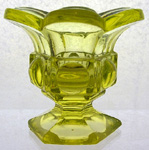
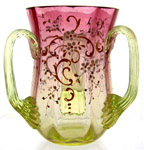
This is a opalescent and decorated vase from Bohemia, circa 1890-1910. The maker is unknown. The photo link shows flash camera, black light, and natural light.

This tall vase with original brass foot is most likely Thomas Webb, England. A gather was made of cranberry and then a larger gather of vaseline glass was made. The vaseline glass also had additives to make it opalescent when reheated, and when the top was reheated to flare out the rim, an opalescent layer gives the cranberry color some added depth. This piece was also decorated. The tall vase was attached to the foot with plaster of paris. This photo also shows three views: flash camera, black light, and natural light.

This cute little pressed OWL creamer has a very pale, dingy vaseline color to it in natural light. The maker is not known from any original catalog source. However, this odd color is also the same odd color of vaseline glass that is found in KITTEN ON PILLOW and DARWIN, two other novelty pieces that are known to have been made by Richards & Hartley of Tarantum, PA. The mould work is also very detailed, which also shows in the Kitten On Pillow and Darwin pieces. Each feather can be seen individually! The creamer is just under 3 3/4″ tall.
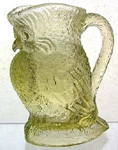
Another novelty creamer is the No. 824 FISH CREAMER made by Central Glass, circa 1887. This is a difficult piece to find in clear or any color! It was made in clear, amber, blue and canary. There is a blue one at the Ogelbay Museum in Wheeling, WV. There is a vaseline glass version at the West Virginia Museum of American Glass in Weston, WV. After it was pressed, the two little tabs were folded over on the top, to form a pouring spout. The tail curves up from the base and the end of the tail attaches at the top to complete the handle. The piece is approximately 6″ long and 4″ tall.
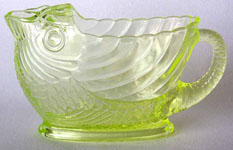
This next piece was found at the EAPG National in Harrisburg, PA during the spring, 2006, show. The seller had purchased three of them in England, as he wanted one for himself. He had the other two for sale. The remaining one was sold later that spring at the Brimfield show and now resides in Texas with another VGCI member. David Peterson did an article on this piece and after the limited research with collectors from England, and the vintage Christmas tree ornament collectors, it was found that no information existed on this piece. As it was made from a spot pattern, a mould had to exist someplace to make three exact balls. This may have also been made as a WITCH BALL. This one looks good sitting on this little sterling silver holder, which was purchased separately. It has been named SNOWBALL ROYALE until (if and when) other information surfaces. It is 3 1/2″ in diameter. This was made with a spot pattern and then blown, leaving a ‘diamond pine cone’ effect on the surface. One English Glass collector has speculated that it was a crib (or backyard) piece, made by a glass master during his free time away from the factory.
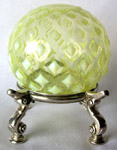
This piece was also made with a spot pattern and was made in the Stourbridge region of England. The applied flower is in the MAT-SU-NO-KE style that Stevens & Williams first used and named. The pattern has been given the modern generic name of HARLEQUIN and several shapes of baskets, bowls, marmalades, and Jack-in-the-Pulpit vases are known. This one has had a small gather of blue glass in the first gather, very much like the Rubina Verde glass highlighted with the TYG cup. Due to the sunlight shining through the blue and yellow layers, the top rim appears green. When it is not in the sunlight, the top rim is blue. Versions with cranberry glass are also known in the HARLEQUIN spot pattern. This piece was made by one of the factories in the Stourbridge region of England during the Victorian era.
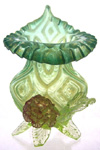
The next two photos show glass made by the same unknown company in the Stourbridge region of England. Numerous pieces of this inner pink with a vaseline glass outer layer are known, in large bride’s baskets, little handled baskets, and in both clear and satin finishes. Speculation has leaned towards Thomas Webb as the maker. It might have also been Stevens & Williams The blown mould pattern is a series of feathers. Some have called this a PEACOCK pattern, due to the bright colors and feather pattern. The first photo shows a little posey vase, with pie crust top rim and paint decoration on the front. The stand seems to be original to the piece. It is weighted brass. The little glass insert measures 3 1/4″ tall. The second photo shows a set of matching decorative ewers that were made to be used as vases. It also has the Peacock blown mould pattern.
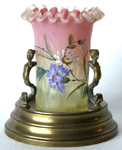
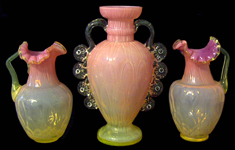
This last piece is a contemporary piece, made by James Whitehurst. It is a very tall presentation goblet, with a fish for the stem. Cobalt glass was swirled to make the eyes. This is a one-off piece constructed without a mould. The cup on the top holds a full pint of liquid! The piece stands 11 3/4″ tall. The foot is 4 1/8″ diameter and the top of the cup is 4 1/4″ in diameter. When constructing this, all the various components (foot, fish stem, bowl) all have to be kept hot enough to accept the other pieces with attached, otherwise a heat check could occur. It was also difficult to make because a piece this large could easily slump once it is in the lehr cooling down.

Remember, IF IT DOESN’T GLOW GREEN, IT’S NOT VASELINE!
Here is a picture of a piece that glows reddish-orange, due to manganese in the glass formula. When buying vaseline glass online, it is important to ask the seller not only whether or not it glows, but if it GLOWS GREEN!
